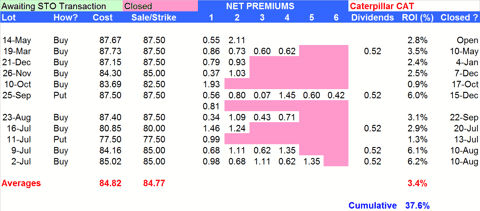 If the recently deceased Harlem Globetrotters’ great player, Meadowlark Lemon had been alive today and helping the equally great band, The Byrds, re-write their classic song, it would likely get a new title.
If the recently deceased Harlem Globetrotters’ great player, Meadowlark Lemon had been alive today and helping the equally great band, The Byrds, re-write their classic song, it would likely get a new title.
The title would perfectly describe what this past week was a all about.
“Spin, Spin, Spin.”
Whether it was post-Iowa Caucus result speeches by the candidates or President Obama’s comments in the aftermath of Friday’s disappointing Employment Situation Report and downward revision to the previous month, it’s easy to see the spin going around and around.
No wonder the stock market is getting dizzy and dizzier, despite its heights getting lower and lower.
With confusion coming from Iowa regarding the definition of “winning” from both sides of the aisle you could easily be excused for shaking your head as the week started.
Then, when a picture of decreasing employment numbers alongside increasing jobless claims numbers was painted as reflecting an increasingly robust economy you could have been further excused for shaking your head into the week’s end.
Politicians who want an opportunity to create a legacy, as well as lame duck politicians who want to cement a legacy are very adept at spin and the ability to portray everything in terms of black and white.
The other side is always wrong and the facts are as portrayed and not as fact.
For stock investors life was much easier when only having to deal with the paradoxical association between oil and stocks.
You simply awoke in the morning and saw where West Texas Intermediate was trading and knew that the stock market would go in the same direction.
Now they’re back into having to decide whether news they hear is good or bad and whether to react appropriately to that news or paradoxically.
Of course, that would be easier if news was really presented on a factual basis and not so quickly subjected to overwhelmingly sanctimonious spin.
With the notion that evidence of a slow down in the economy would make the likelihood of further Federal Reserve rate hikes less, bad news was once again being taken as good news. The predominance of oil, however, as a factor in the market’s direction may have been obscuring some of that newly rediscovered fractured thought process.
With the market having spent the week going back and forth with numerous large intra-day moves and some large daily moves, it all came down to Friday’s trading to determine the fate of the DJIA for the week, as it had only been 34 points lower heading into the final day of trading. That week included one day with a loss of 290 points and the following day with a gain of 193 points.
If you were among those for whom confidence could have been inspired by those kind of movements, then any kind of upcoming spin could have led you in any direction.
Of course, the direction also depended on whether you are now of the increasing frame of mind that good news is bad news.
While we awaited Friday morning’s Employment Situation Report release and the DJIA had been down only 0.2%, the broader indexes weren’t faring quite as well.
The S&P 500 had already been 1.3% lower on the week and the NASDAQ 100 was down 2.6%.
With Friday morning’s release, the data, while disappointing was likely not weak enough to give cause for much celebration for those looking for good reason to dismiss the possibility of future interest rate hikes in 2016.
What may have cast a pall on the market was the Presidential spin that focused on the 4.9% jobless rate and wage growth.
If you were among those interpreting bad news as being good, you had to interpret that kind of spin as being good news.
And that can only be bad as the FOMC had certainly not closed the door on further interest rate increases in its recent statement.
While the DJIA lost an additional 1.3% to end the week, the NASDAQ 100 tacked on an additional 3.4% to its already sizable loss for the week, while the S&P 500 lost an additional 1.9%.
Good luck trying to spin that as we begin to prepare for the coming week.
As usual, the week’s potential stock selections are classified as being in the Traditional, Double Dip Dividend, Momentum or “PEE” categories.
Having suffered the direct blow from decrease oil prices and the indirect blow from what those decreasing prices have wrought upon the market, it’s not easy to consider adding another energy position.
Who can begin to count the number of times over the past 15 months that it didn’t look as if we had hit a once in a generation kind of rock bottom bargain price for a barrel of oil?
With ConocoPhillips (NYSE:COP) having just slashed its dividend, you do have to wonder whether British Petroleum (NYSE:BP) could be next.
WHile its dividend this week is presumably safe, it’s harder to make that case for the remainder of 2016 if rude prices continue to test lows. In its defense, British Petroleum is better diversified than ConocoPhillips is after having spun off its refining assets a few years ago, but the risk of insufficient cash flow is still there.
What is also there is a very nice option premium in reflection of further risk.
Looking at the option premiums, I am inclined to look at more than a weekly option contract, as is normally my approach for positions going ex-dividend during the week.
The exaggerated volatility of the past 2 weeks is really enhancing the premium and the dividend is extraordinary, while likely having more safety than the option market may be surmising.
Also ex-dividend this week are DuPont (NYSE:DD) and International Paper (NYSE:IP).
While DuPont has gone considerably higher in the past two weeks, I believe that in the absence of general market weakness it can recapture much of what had been lost following the announcement of a complex deal with Dow Chemical (NYSE:DOW).
With some strength also seen in Dow Chemical recently, I took the opportunity to sell calls on uncovered shares and is a portion of the strategic theme for this week, I used an out of the money strike price and a longer term time frame than I would normally consider in an effort to lock in some higher volatility driven option premiums and to regain lost share value.
The same approach holds for if considering a purchase of International Paper.
While it’s recent earnings report exceeded expectations and met whisper numbers, its stock price trend for the past year has been decidedly lower and lower, even in the absence of structural or operating issues.
While its payout ratio is getting uncomfortably high, the generous premium should continue to be safe and I might consider locking in the premium for a longer term, perhaps to even encompass an additional ex-dividend date in May 2016, although upcoming earnings would also have to be considered if doing so.
For that reason, I might even consider going out to a July 2016 expiration in the anticipation that some of that lost luster in its price will be regained by then,
Although not ex-dividend this week, EMC Corporation (NYSE:EMC) is among some of those fallen angels in the technology sector and which are beginning to celebrate their newly found volatility with some enhanced option premiums.
Somehow lost in the story with EMC is that there is a buyout offer that appears to be on track for completion and at a price that is substantially higher than Friday’s closing price.
I’m not one to play in the same arena with those expert in the science and art of arbitrage, but this one seems to offer some opportunity, even as the deal isn’t expected to close until the end of the year.
While there may still be regulatory hurdles head, EMC appears to be a willing partner and while awaiting a decision, there are still some dividends to be had.
For that reason, I might consider buying shares and selling a longer term and significantly out of the money option contract. Since I also already have existing shares at $30, I might consider combining lots and selling calls at a strike below the cost of the original lot, not counting accumulated premiums and dividends.
Finally, I just don’t think that I can any longer resist buying shares of eBay (NASDAQ:EBAY) at this level.
eBay was one of my more frequent holdings until the announcement of its definitive plan to spin off its profitable PayPal (NASDAQ:PYPL) unit.
What could be more appropriate when talking about the week’s spin than to look at a post-spin eBay?
For years I loved holding eBay as it made little net movement, even as it had occasional spikes and plunges usually earnings related. All that meant was that it had an attractive option premium, with relatively little risk associated with it, as long as you didn’t mind those occasional plunges that were inevitably reversed.
WIth no real challenge ahead of it other than market risk in general, eBay is now at its post spin-off low and is offering a great option premium for what I perceive to be low risk.
WIth those premiums so attractive, but mindful that there may be near term market risk, I would probably think in terms of selling longer term and out of the money call contracts on any shares that I purchased.
While the market could continue to be further dragged down by declining oil prices and while games are still being played with what economic data really means and how it should be interpreted, you do have to wonder how any of that impacts eBay.
I know that I do.
Traditional Stocks: eBay, EMC Corporation
Momentum Stocks: none
Double-Dip Dividend: British Petroleum (2/10 $0.59), DuPont (2/10 $0.38), International Paper (2/11 $0.38)
Premiums Enhanced by Earnings:
Remember, these are just guidelines for the coming week. The above selections may become actionable – most often coupling a share purchase with call option sales or the sale of covered put contracts – in adjustment to and consideration of market movements. The overriding objective is to create a healthy income stream for the week, with reduction of trading risk.

 Everything is crystal clear now.
Everything is crystal clear now.
 The hard part about looking for new positions this week is that memories are still fresh of barely a week ago when we got a glimpse of where prices could be.
The hard part about looking for new positions this week is that memories are still fresh of barely a week ago when we got a glimpse of where prices could be.

